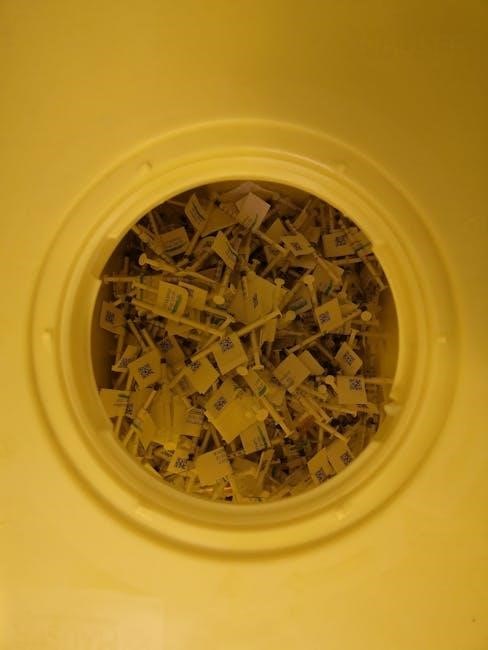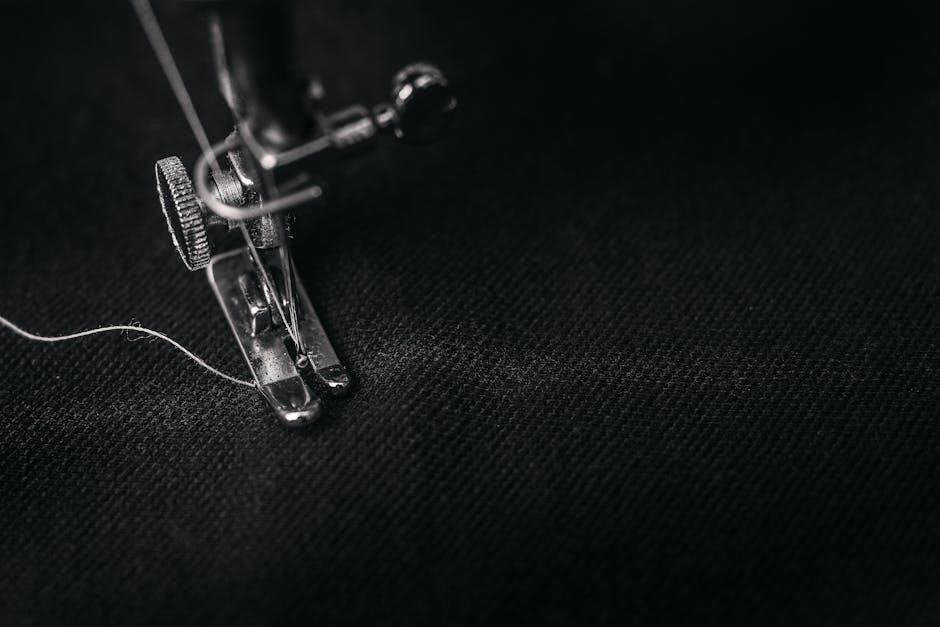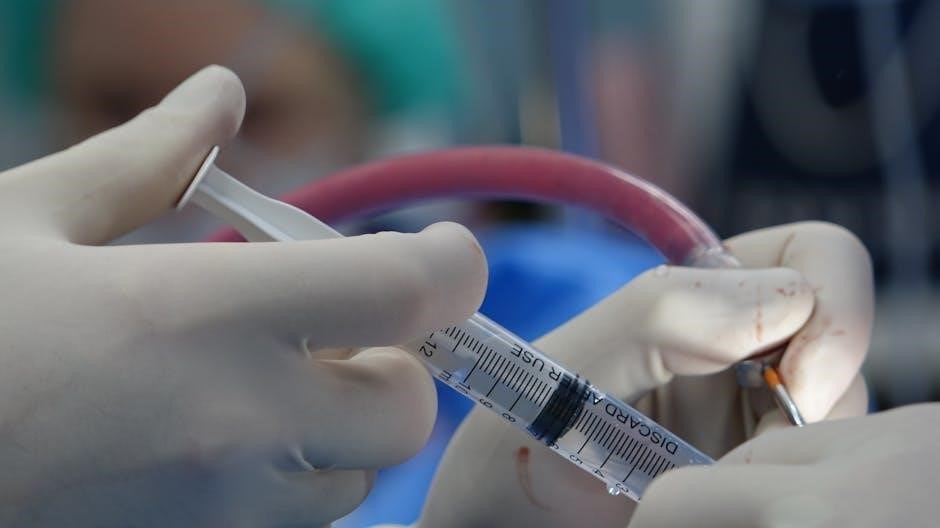A Needle Stick Injury (NSI) Protocol outlines standard procedures for immediate response, prevention, and documentation. It ensures proper care, reduces infection risks, and promotes compliance with workplace safety regulations.
1.1 Overview of Needle Stick Injuries (NSI)
Needle Stick Injuries (NSIs) are a common occupational hazard, particularly in healthcare settings, involving puncture wounds caused by needles or other sharp medical instruments. These incidents pose significant risks of exposure to bloodborne pathogens, such as HIV, Hepatitis B, and Hepatitis C. NSIs often occur during procedures like injections, blood sampling, or disposal of sharps. They are a critical concern due to their potential to transmit infectious diseases, making prompt response and prevention strategies essential. Understanding the scope and impact of NSIs is vital for developing effective protocols to minimize risks and ensure worker safety. This overview provides a foundation for addressing the complexities of NSIs and the importance of standardized protocols in mitigating their consequences.

1.2 Importance of a Standardized Protocol
A standardized protocol for Needle Stick Injuries (NSIs) is critical to ensuring consistent, effective, and timely responses. It provides clear guidelines for immediate actions, such as wound care and reporting, as well as long-term follow-up, including medical testing and documentation. Without a standardized approach, the risk of improper handling and delayed treatment increases, potentially leading to severe health consequences. A protocol also ensures compliance with workplace safety regulations and reduces liability for employers. By establishing a uniform procedure, it helps minimize confusion during emergencies and promotes a culture of safety and accountability. Standardized protocols are essential for protecting healthcare workers and maintaining a safe working environment.

Definition and Scope of Needle Stick Injuries
Needle Stick Injuries (NSIs) involve punctures by needles or sharp objects, potentially transmitting bloodborne pathogens like HIV, HBV, and HCV. They are common in healthcare settings among workers handling sharps.
2.1 What Constitutes a Needle Stick Injury?

A Needle Stick Injury (NSI) is a percutaneous wound caused by a needle or sharp object, potentially exposing individuals to bloodborne pathogens like HIV, HBV, and HCV. It involves accidental punctures during medical procedures, handling sharps, or contact with contaminated needles. NSIs can occur in healthcare settings, laboratories, or other environments where sharps are used. Even minor punctures can pose significant infection risks, especially if the needle was previously used on a patient with a bloodborne infection. The injury is considered high-risk if the needle was contaminated with blood or other bodily fluids. NSIs are a serious occupational hazard, particularly for healthcare workers, laboratory staff, and emergency responders. Prompt reporting and treatment are crucial to prevent potential infections and ensure proper follow-up care.
2.2 High-Risk Professions and Settings
High-risk professions for needle stick injuries include healthcare workers, nurses, surgeons, laboratory staff, and emergency responders. These individuals frequently handle sharps, blood, and bodily fluids, increasing exposure risks. Settings with elevated NSI risks include hospitals, clinics, surgical units, laboratories, and emergency departments. Nurses, in particular, are at high risk due to their frequent use of needles in patient care. Laboratory personnel handling blood samples and sharps also face significant exposure. Emergency responders, such as paramedics and firefighters, may encounter sharps in unpredictable environments. Additionally, settings with insufficient safety protocols or high patient turnover amplify the likelihood of NSIs. These professions and environments require heightened vigilance, proper training, and adherence to safety measures to mitigate risks and protect workers from bloodborne pathogen exposure.

Immediate Steps After a Needle Stick Injury
Wash the wound with soap and water, report the incident, and seek immediate medical attention to minimize infection risks and ensure proper follow-up care.
3.1 First Aid and Wound Care

- Immediately wash the affected area with soap and water to reduce contamination risk.
- Allow the wound to bleed naturally to flush out potential pathogens.
- Apply a waterproof dressing to protect the wound from further exposure.
- Flush exposed mucous membranes or eyes with water for at least 10 minutes.
- Avoid using harsh chemicals, bleach, or cauterizing the wound.
- Do not suck the wound or apply tight bandages.
- Seek medical attention promptly for further evaluation and treatment.
Proper wound care is critical to minimize infection risk and promote healing after a needle stick injury.
3.2 Reporting the Incident
Following a needle stick injury, immediate reporting is crucial for ensuring proper follow-up and care. Inform your supervisor or workplace safety officer promptly to initiate the incident reporting process. Complete any required incident forms, detailing the circumstances of the injury, including the type of needle, potential contamination, and the individuals involved. Provide accurate information to facilitate a thorough investigation and implementation of preventive measures. Proper documentation ensures accountability and adherence to safety protocols, safeguarding both the affected individual and the workplace environment. Timely reporting also enables swift medical evaluation and necessary interventions to minimize health risks. Always maintain a record of the incident for future reference and legal compliance.

Preventive Measures to Reduce NSI Risk

Preventive measures are crucial to minimize NSI risks. Implement safety protocols, proper sharps handling, and use of safety-engineered devices to create a safer workplace environment and reduce incidents effectively.

4.1 Safe Handling and Disposal of Sharps
Safe handling and disposal of sharps are critical to preventing NSIs. Use tongs or forceps to handle sharps, avoid recapping needles, and dispose of them in puncture-proof containers. Proper training ensures adherence to protocols, reducing risks and protecting against bloodborne pathogens. Employers must provide appropriate containers and ensure staff follows correct procedures. Regular audits and maintenance of disposal systems further minimize hazards. Compliance with these guidelines significantly reduces the likelihood of sharps-related injuries and promotes a safer workplace environment.
4.2 Use of Safety-Engineered Devices
The use of safety-engineered devices is a cornerstone in reducing needle stick injuries. These devices are designed with protective features such as retractable needles, shielding mechanisms, or self-sheathing systems to minimize exposure. Safety-engineered syringes, scalpels, and phlebotomy devices are widely recommended. Employers should prioritize the procurement and use of these tools to create a safer working environment. Training on the proper use of safety-engineered devices is essential to ensure their effectiveness. Regular updates to newer technologies can further enhance safety. The implementation of these devices significantly lowers the risk of sharps injuries, protecting healthcare workers from bloodborne pathogen exposure. Compliance with safety standards and device regulations is critical for optimal workplace safety.
Documentation and Follow-Up
Proper documentation of needle stick injuries ensures accountability and guides medical follow-up. Detailed records of the incident and subsequent care are essential for legal and health monitoring purposes.
5.1 Importance of Proper Documentation
Proper documentation of needle stick injuries is critical for ensuring accountability, tracking incidents, and providing a clear record for legal and medical purposes. It helps in identifying patterns of exposure and assessing risks associated with the injury. Accurate records include details such as the circumstances of the incident, the type of device involved, and the individuals exposed. This information is vital for guiding follow-up care and evaluating the effectiveness of post-exposure prophylaxis (PEP). Additionally, documentation supports audits and compliance with occupational safety regulations. Timely and detailed reporting also aids in preventing future incidents by identifying high-risk areas and improving safety protocols. Without proper documentation, healthcare facilities may face challenges in managing exposures effectively and ensuring worker safety.
5.2 Medical Follow-Up and Testing
After a needle stick injury, immediate medical follow-up is essential to assess the risk of infection and initiate appropriate treatment. The exposed individual should undergo testing for bloodborne pathogens such as HIV, hepatitis B, and hepatitis C. Baseline blood tests are typically conducted within 48 hours of the incident, with follow-up tests scheduled at intervals of 1-2 weeks, 3 months, and 6 months. Post-exposure prophylaxis (PEP) may be prescribed to prevent HIV infection if the risk is determined to be high. Medical professionals will monitor the individual for signs of infection and provide guidance on symptom recognition. Proper medical follow-up ensures timely intervention, reduces the risk of long-term health consequences, and supports the overall well-being of the affected worker.
